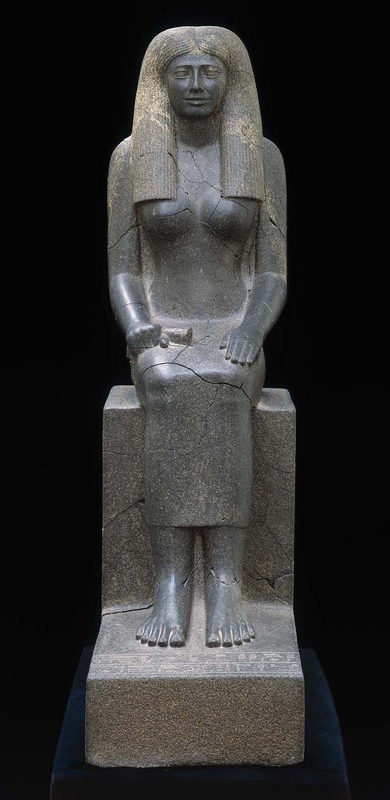Lady Sennuwy
Title
Date
Artist or Workshop
Materials
Height of the work
Provenience
Current Location
Description and Significance
Description:
The portrait of “Lady Sennuwy” depicts a female figure seated on a stone block with her legs together and arms placed on her thighs. The right hand is clasped into a fist, holding a lotus blossom, the symbol of rebirth and the assurance of eternal life. The left hand of the figure rests with the palm flat on the thigh. The composition is frontal with the body of the figure shown in axial alignment. The figure wears a tightly fitted sheath dress that extends to her shins and emphasizes the elegant proportions of her feminine shape, particularly her narrow waist and full breasts. She is depicted as an idealized young woman: slender and eternally youthful. The face of the figure is carefully modelled into an expression of serenity; the face is delicate and refined so to express the inner personality of the subject through expressive realism common during the Middle Kingdom period. The deep gray granodiorite stone of the figure has been shaped and smoothed by the unknown artist, who scholars suggest was trained in a royal workshop. The polished nature of the stone indicates that the portrait was never painted. The smooth quality of the skin and placid expression mirror the symbolism of the lotus flower to suggest the sitter’s continuation into eternity. The wig worn by the figure is long and straight, falling to the breasts. The figure’s title and veneration in the presence of Osiris and other deities of the afterlife are listed in hieroglyphs in front of the feet and on the sides of the base where the figure sits.
Significance:
As the wife of the provincial governor of Asyut, Lady Sennuwy had access to high quality materials and accomplished artists for her portrait representation, suggesting the incredible wealth and importance of the couple during the reign of Senwosret I in the Middle Kingdom. The portrait of Lady Sennuwy, along with a similar sculpture of her husband, Djefaihapi, was likely housed in a tomb chapel or sanctuary in their rock-cut tomb (the largest nonroyal tomb of the Middle Kingdom). Despite the suggestion of the original placement of the portraits, at the time of excavation in 1914, the two figures were found buried in Kerma, inside of the tumulus of a Nubian king. Scholars believe that three-hundred years after the creation of the statues, they were removed from their original context within the couples’ tomb in Asyut and exported to Nubia (Sudan). Though the reason for the statue’s exportation is still unknown, its importance as a funerary portrait remains significant. Many portraits of the Middle Kingdom work towards a fidelity to nature in the presentation of the human body, and the portrait of Lady Sennuwy is a wonderful example as it is beautiful in its proportion and attention to detail, particularly in the rendering of the facial features. The polished gray granodiorite used for the creation of the portrait was often utilized as a symbol in funerary portraiture to suggest new life, resurrection, and the resurrected god of the dead, Osiris, who is mentioned in the hieroglyphs on the figure’s base. The importance placed on rebirth and the eternal in the figure, from her youthful appearance, allusions to Osiris, and symbolization of the lotus flower, conveys the significance placed on the preservation of personal identity from the life of the sitter into the afterlife.
References
"Ancient Egypt: Symbols of the Pharaoh." The British Museum, www.britishmuseum.org/PDF/Visit_Egypt_Symbols_KS2b.pdf.
Janson, H. W., and Anthony F. Janson. History of Art: The Western Tradition. 6th ed., Upper Saddle River, Pearson/Prentice-Hall, 2004. 59-60. Print.
Robins, Gay. The Art of Ancient Egypt. Rev. ed., Cambridge, Harvard UP, 2008. 24. Print.
"Statue of Lady Sennuwy." Museum of Fine Arts Boston, www.mfa.org/collections/object/statue-of-lady-sennuwy-141967.
Contributor
Citation
Item Relations
This item has no relations.

